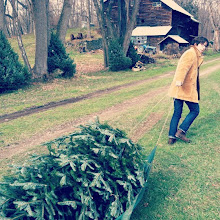
Overlook Mountain rises just north of Woodstock in the southeast corner of the Castkill Park. The trailhead is across from a Buddhist Temple high on the slope. To get there, you just follow Rock City Road from the middle of town all the way up.
Most of the trail is wide and lined with gravel. It follows a steep jeep trail that runs to a transmitter near the summit. I passed a lot of people going up (one of whom was barefoot), but it still felt quiet. The edge of the trail was feathered with green ferns.
Most of the trail is wide and lined with gravel. It follows a steep jeep trail that runs to a transmitter near the summit. I passed a lot of people going up (one of whom was barefoot), but it still felt quiet. The edge of the trail was feathered with green ferns.

After two miles, I walked into a cloud bank. A haze clung to the edge of everything, and it felt the sky was just past the trees.

Near the summit, the trail goes through the ruins of the Overlook Mountain House. Built in 1870, it enjoyed brief favor as an elite resort (Ulysses S. Grant stayed there when he was president; they called it "the summer White House") before it burned down in 1875.

In the 1960s, the state of New York set controlled fire to what was left, leaving behind a yawning shell of rock.




















